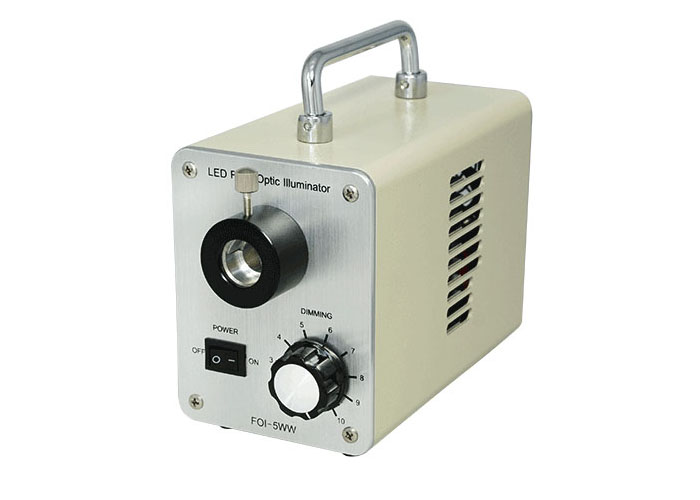Lens aberrations can be divided into two major categories, namely monochrome aberrations and chromatic aberrations. Fiber optic illuminator factory shares with you.
There are five kinds of monochromatic aberrations of the lens, which are the spherical aberration, coma aberration, astigmatism, field curvature, and distortion that affect the similarity of the object image.
The following describes five different types of monochromatic aberrations.
1. Spherical Aberration
It is caused by the different condensing power of each point on the lens spherical surface of the lens. The parallel rays coming from infinity should theoretically converge on the focal point. However, because the convergence point of the near-axis light rays and the far-axis light rays are not consistent, the converging light rays do not form a point, but a concentric circle symmetrical about the optical axis. This aberration is called spherical aberration. The existence of spherical aberration caused the blur of imaging, and as can be seen from the figure below, this blur is related to the size of the aperture. When the aperture is small since the diaphragm blocks the far-axis light, the diameter of the circle of confusion is small, and the image will be clear. When the aperture is large, the diameter of the circle of confusion is large, and the image will be blurred.
It must be noted that this kind of image blur caused by spherical aberration and the blur in the depth of field is completely separate, and should not be confused. Spherical aberration can be eliminated to the greatest extent through compound lenses or aspheric mirrors. In the camera lens, the aperture number is increased by one (the aperture is reduced by one), and the spherical aberration is reduced by half. When we shoot, as long as the light conditions allow, we can consider using a smaller aperture to reduce the effect of spherical aberration.

2. Coma
It is a kind of aberration generated when imaging off-axis. A parallel beam of light is emitted from a point outside the optical axis to the lens. After passing through the optical system, it does not form an image of a point on the image plane but forms an asymmetric diffuse spot. This diffuse spot is shaped like a comet. Dragging a thin to thick tail from the center to the edge, the head end is bright and clear, and the tail end is wide, dark, and fuzzy. This aberration caused by off-axis light beams is called the coma. The magnitude of coma is related to both the aperture and the field of view. We can also adopt a smaller aperture to reduce the effect of coma on imaging.
3. Astigmatism
It is also an off-axis aberration. Unlike a coma, astigmatism is only related to the field of view. Due to the asymmetry of the off-axis beam, the convergent point of the meridional thin beam (that is, the diameter direction of the lens) of the off-axis point is different from the convergent point of the sagittal thin beam (the direction of the circular arc of the lens). This phenomenon is called Astigmatism. Astigmatism can be understood against the astigmatism of the eyes. Eyes with astigmatism actually have inconsistent curvatures of the lens in both directions, causing the points seen to disperse into a short line.
Astigmatism also greatly reduces the image quality of off-axis imaging. The size of the astigmatism is only related to the angle of view, not the aperture. Even if the aperture is very small, it is still impossible to obtain a very clear image at the same time in the meridian and sagittal directions. In wide-angle lenses, astigmatism is more pronounced due to the larger field of view. When shooting, we should try to keep the subject in the center of the screen. This seems to be in conflict with the composition requirement not to put the main object of expression in the center of the drawing. How to master it depends on the actual situation.
Our company provides an optic illuminator.
Copyright:@2020-2021
Comments Please sign in or sign up to post.
0
0 of 500 characters used